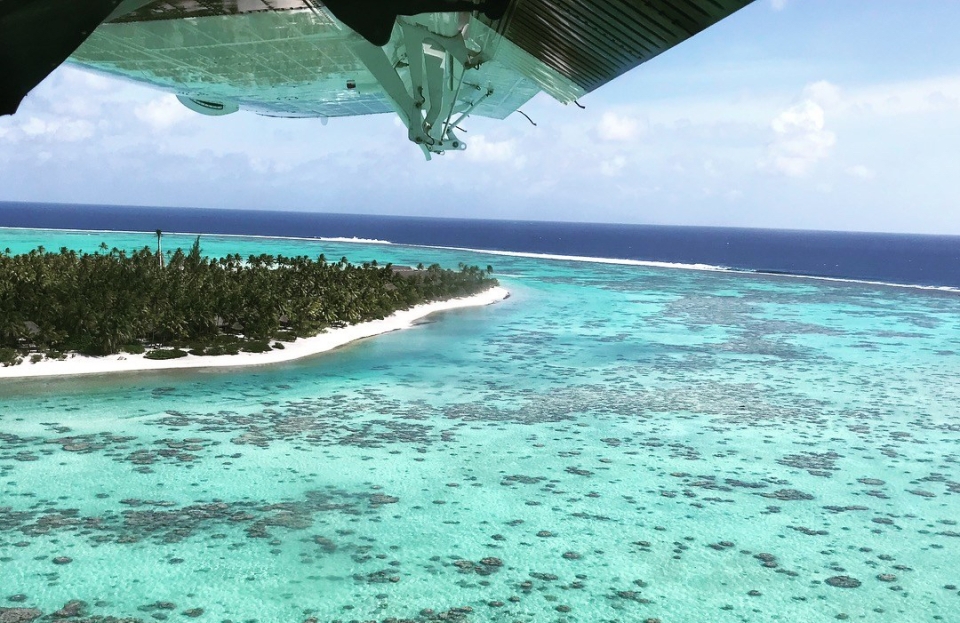
The atoll of Tetiaroa. Image is the property of The Brando resort.
It’s true, paradise does exist. And it is Tetiaroa. Tetiaroa is an atoll in the Windward group of the Society Islands in French Polynesia located 33 mi from Tahiti. The atoll has only 6 square kilometres (2 sq mi) of total surface area divided by 12 motus (islets), but it makes up for its modest size by encircling a truly world unique lagoon. The lagoon is approximately 7 kilometers wide and ranges in depth from only a few centimeters at the shore to 30 meters at its deepest point and is filled with clear, turquoise water and abundant marine life. The isolation and beauty of the atoll made it a top vacation spot for Tahitian royalty and in more recent times is known for having been purchased by and served as a primary residence for Marlon Brando. It is now home to The Brando, a luxury eco-resort. The allure of Tetiaroa attracted not only royalty but the mosquito Aedes polynesiensis, a vector of dengue, lymphatic filariasis and likely Zika virus, as well.

View of the outer reef of Tetiaroa
Ae. polynesiensis is a semi-domestic species found only in the South Pacific with an extremely wide range of breeding places that includes tree holes, a wide range of artificial containers, crab holes, canoes, coconut shells and husks, of which there are plenty on Tetiaroa. In addition to their vector status, they can cause great nuisance to locals and vacationers alike, destroying a long-awaited honeymoon or relaxing retreat. So, if you want to formulate a plan to eradicate a pest to improve paradise while also undertaking an ambitious experiment that could change how we fight mosquitoes and the diseases they spread, there is no better setting than Tetiaroa.

Aedes polynesiensis female
The project to eliminate Ae. polynesiensis from Tetiaroa is led by medical entomologist Hervé Bossin and his team at the Institut Louis Malardé in collaboration with the Tetiaroa Society, a non-profit research and conservation organization dedicated to understanding the wonders of Tetiaroa, and The Brando resort. The plan involves releasing large numbers of Wolbachia-infected male Ae. polynesiensis into the wild to reduce and eventually eradicate the species from the island. Wolbachia are a group of intra-cellular bacteria that live inside many insect species, including mosquitoes, and when a male mosquito infected with Wolbachia mates with a female not infected with Wolbachia, or infected with a different strain, the fertilized eggs fail to develop due to what is called cytoplasmic incompatibility. Hervé and his team have already released more than 1 million sterile male mosquitoes on the island starting in 2015, triggering a hundredfold drop in the mosquito population. Today, over a year after the end of releases, the mosquito population on the islet of Onetahi where the study took place is 1/10th what is was prior to the Wolbachia releases.

Male and female larvae being separated prior to release at the Institut Louis Malardé

Buckets of Ae. polynesiensis pupae being sorted prior to release
However, there is still much to learn before additional releases are performed. In particular, male Ae. polynesiensis ecology is still poorly understood. Questions such as, “how far will a male fly?” and “how long does a male live?” are still unanswered. It is essential to answer these and many other questions to optimize future releases and maximize population suppression. To help fill in these knowledge gaps, Hervé and ILM have arranged for a gathering of some of the world’s premier medical entomologists and mosquito ecologists for a workshop on male-based control strategies, including Wolbachia. Prior to the workshop, a small group of researchers, including myself (Brian), will perform a series of mark-release-recapture experiments on Tetiaroa. These experiments will involve the release of 45,000 male Ae. polynesiensis marked with fluorescent powder to obtain accurate estimates on male dispersal (flight range) and survivorship post-release, as well as investigations into novel male surveillance strategies.

Herve Bossin and members of the Tetiaroa Society setting a BGS trap prior to the MRR experiment

The traps are suspended above the ground to keep them away from rodents and to stop ants from stealing captured mosquitoes
The experiments have yet to take place, but we are already excited about the outcomes! More updates on the workshop and MRR experiments will follow shortly.

Sunset on the beach of Onetahi islet in Tetiaroa










